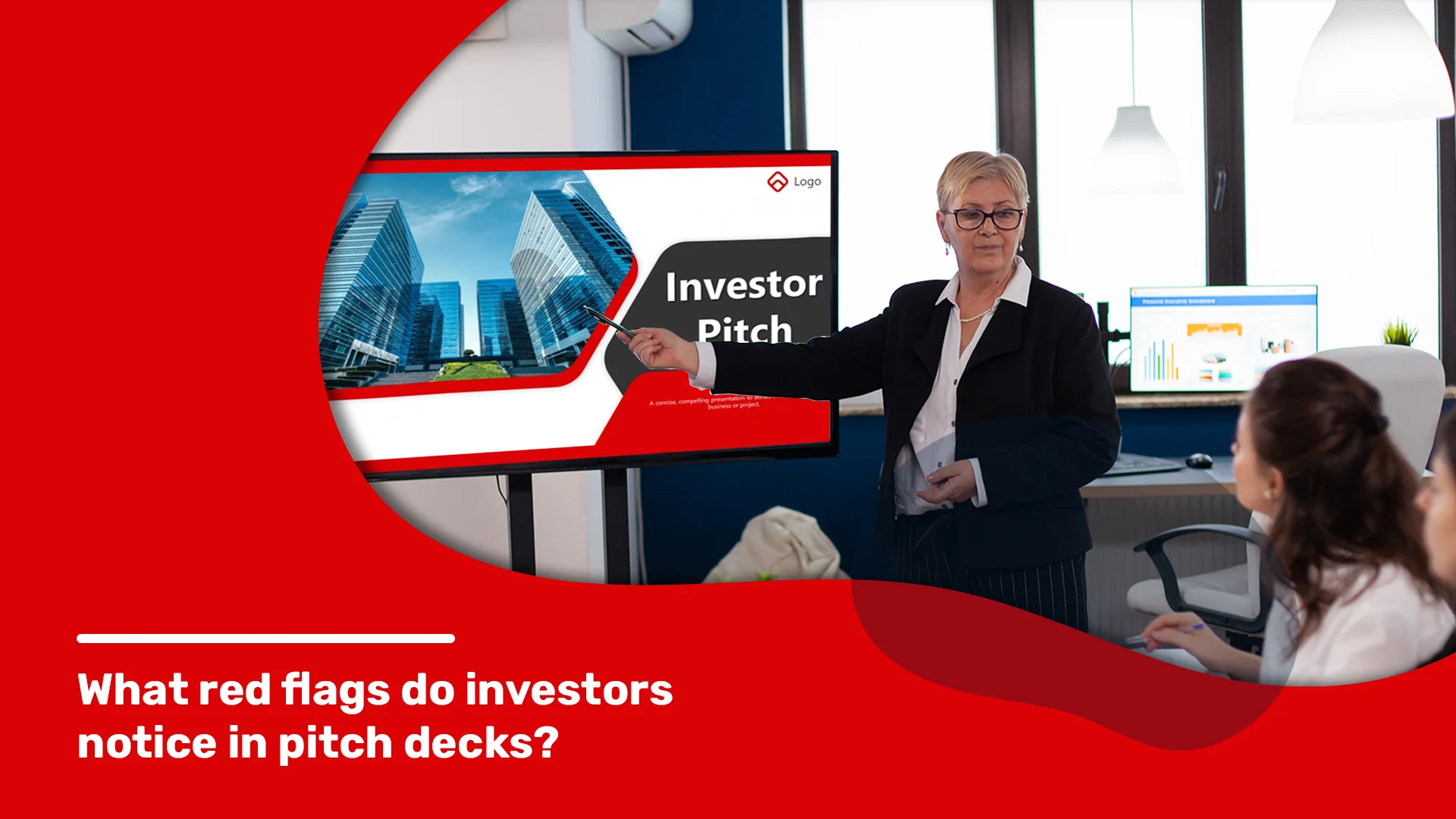Introduction
A pitch deck is one of the most important tools that a startup can use to get funding. They are the first impression of your business, and the quality of it means that investors will either be interested in pursuing your startup or will look elsewhere for investment. Understand what a pitch deck is and create a polished investor deck. But building a fund deck is not just about telling a nice story. It also means preventing things that can turn off investors. It is about presenting a beautiful product and tremendous market opportunity. To avoid getting on investors’ nerves, entrepreneurs should be mindful of the red flags that signify these exceptional opportunities and even use this to influence their unfabricated funding decks.
In this blog, we have discussed some common red flags that cause investors to pause and also given some tips about how to avoid making such mistakes. Knowing these problems will allow entrepreneurs to adjust their pitch deck accordingly and gain the funding they want.
Common Red Flags in Pitch Decks
1. Lack of Clear Value Proposition
A value proposition that is not well articulated stands out to investors as one of the biggest red flags. If investors are not quickly able to understand what sets your product or service apart, they may question whether you have a business at all. A muddled or nebulous value proposition indicates that the startup has not fully crystallized how it stands out in this market compared to competitors, which makes it hard for investors to assess what their potential return on investment could be.
Tip:
Instead, focus on a concise definition of what your product or service is unique about. Explain what problem you’re trying to solve and why it’s better than existing alternatives instead of broad ideas. Do not make vague statements. Instead, create specific benefits that would appeal to your target market. So it is the most important thing that investors should see in your presentation; it sets the tone for everything you are going to say.
2. Unrealistic Financial Projections
Investors immediately recognize such overly optimistic revenue forecasts without credible justification. Pitch decks with unbelievable financial projections seem naive or even worse in the intention to deceive. Investors are dubious of anything that looks too good to be true, like outsized revenue growth without a clear path or cost and expense figures that seem unrealistically low. These projections can lead to all sorts of financial and strategic questions about the startup, which is not ideal.
Tip:
Your financial projections shall be data-driven and based on realistic assumptions. All your forecasts must be supported by market research, industry benchmarks, and early traction data. Be ready to support your numbers when asked, and demonstrate that you have done different scenarios as well as taken the risk of failure into account. A balanced view of your financial outlook will clearly convey to investors that you have a good handle on your business economics.
3. Poorly Designed Pitch Decks
You only have one chance to make a first impression, and a pitch deck riddled with spelling mistakes, unprofessional graphics, or too much clutter can quickly compromise investor interest in taking your startup seriously. A bad pitch can possibly dash the message because of an ill-designed pitch deck and the loss of confidence regarding the attention to detail and professionalism of the start-up.
Tip:
It may also be a good idea to spend money on having the presentation look nice and neat in order to help guide them through your points. Ensure you are using consistent branding and crisp images and that the layout is clear to guide investors through your narrative. If design isn’t your strong suit, you could always work with a professional pitch deck design service provider that focuses on crafting visually compelling presentations. A good pitch deck will make you look professional and will help you convey a clearer message.
4. Overlooking the Competition
A red flag includes not showing any analysis of the competitors or the competitive landscape. then I guarantee you have nothing other than a poor understanding of the market, if any at all. Investors realize that all markets are competitive, if you fail to acknowledge your competition, that makes your startup look naive or unprepared. Any investor will want to know that you have a way to differentiate your business and that you know the market environment.
Tip:
It is essential to do the groundwork of market research and also clearly state your competitive edge. Recognize the major players in your sector and detail what makes your startup different. Discuss unique qualities, pricing advantages, or alliances that place you ahead of the competition. It demonstrates that you know the competitive landscape and have a plan of attack.
5. Too Much Technical Jargon
The use of too much technical jargon might discourage potential investors, and especially if they are not as well-versed in your specific industry or tech variation. Too much laced-up jargon and fancy terms in a pitch deck might create a disconnection, where investors will find it difficult to understand the core of your business. This might lead to confusion, misunderstandings, and ultimately, losing their interest.
Tip:
Simplify the language of your pitch deck so that it will be able to grab the attention of all readers, irrespective of whether they are tech-savvy or not. Explain the benefits of your product or technology to the user, and not get lost in the technical details. Try to use analogies with concepts supported by visuals and straightforward descriptions so it is easy to handle. Potential customers want to hear the gist of your enterprise just in its simplest form, many times in layman’s terms.
Key Slides to Watch Out For
1. The Solution Slide
Red Flag: Make sure the solution slide addresses the problem you described in the pitch. Don’t be vague about what your product or service does because this may lead investors to believe your solution is ambiguous or confusing.
2. The Market Opportunity Slide
Red Flag: A fragmented or poorly researched market opportunity slide can just kill the pitch. Investors need to see a clear potential customer base and get a sense of market size. If you cannot present that convincingly, it will bring into question your startup’s scalability and growth potential.
3. The Team Slide
Red Flag: It’s one of the most common mistakes not fully representing the expertise and relevant experience of the team. Investors tend to say they invest in the people as much as they do the ideas, so it’s quite important to show that your team has the skills and background to implement the business plan. A weak team slide can really erode investor confidence.
Conclusion
Investors look for clear, credible, and compelling presentations to present how you are proposing a startup and that you might actually know what you’re talking about in terms of market fit and competition. Avoid common red flags such as a value proposition unclear, the financials unrealistic, poor design, ignoring competition, and too much jargon.
Making a great pitch deck for investors would be an art and science itself. Keep it clear, realistic, and professionally done. All of these will raise the chances of convincing investors to give you the investment necessary to take your startup to the next level.









